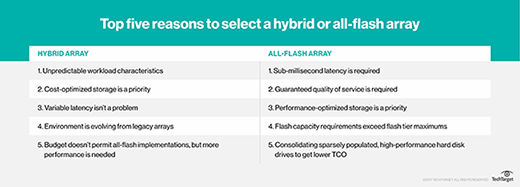
hybrid flash array
What is a hybrid flash array?
A hybrid flash array is a solid-state storage system that contains a mix of flash memory drives and hard disk drives (HDD).
Hybrid flash arrays employ form factors and electrical interfaces that are compatible with common HDD bays. This enables a gradual replacement of spinning hard disks with solid-state drives (SSDs), if desired.
Flash memory, which has no moving parts, is a type of non-volatile memory that can be erased and reprogrammed in units of memory called blocks. It's a variation of electronically erasable programmable read-only memory (EEPROM), which got its name because its memory blocks can be erased in a single action or flash. A flash array can transfer data to and from SSDs much faster than electromechanical disk drives.
Flash is more expensive than spinning disk, but the development of architectures such as multi-level cell (MLC), triple-level cell (TLC) and quad-level cell (QLC) have lowered prices and improved capacities. Even so, these improvements sacrifice performance and durability. Single-level cell (SLC) is the fastest and most durable type of SSD, but SLCs are expensive and very limited in capacity and are rarely used today. QLC SSDs are generally the least expensive option, but they have characteristically sluggish performance and poor durability. Various technologies have been developed to improve the overall durability of SSDs to the point that they are suitable for enterprise use.
What are the benefits and drawbacks of a hybrid flash array?
The difference between a hybrid flash array and an all-flash array (AFA) is that hybrid storage arrays have a mixture of HDDs and SSDs, while an all-flash array is equipped only with SSDs. A hybrid storage array can feature a lot of flash or just a little. Adding a small number of SSDs to a traditional array can improve its overall performance immensely, and it involves less of an upfront expense than an AFA.
HDDs are predictable and offer a low cost per gigabyte. However, they use a lot of power and are comparatively slow. SSDs offer fast performance and use much less power than HDDs. However, SSDs are more expensive on a per-gigabyte basis, and an all-flash array can be cost-prohibitive.

At one time, AFAs were also known for their very limited storage capacities. SSD capacities have vastly improved in recent years, with multi-terabyte drives becoming the norm. Even so, enterprise SSDs continue to have a significantly higher cost per gigabyte than HDDs.
Hybrid storage arrays are the best of both worlds: They offer a relatively low cost per IOPS (input and output operations per second) and per gigabyte, as well as balanced cost for performance. Hybrid arrays meet the needs of most workloads because they make more IOPS available and reduce storage latency.
Hybrid flash storage systems are right for any organization that needs faster access to stored data than spinning disk can provide. If all of an application's data doesn't need to be available to users at any given moment, then storing hot data on SSDs is a good idea. For this reason, many applications -- from collaboration and email applications to virtual desktop infrastructures (VDIs) -- benefit from added flash.
How do hybrid flash arrays affect enterprise storage?
There are hybrid storage arrays that ship with HDDs and SSDs in the same box. Alternatively, hybrid flash storage customers can attach flash drives directly to server PCIe (Peripheral Component Interconnect Express) slots. The second option is usually more expensive but delivers faster storage performance because the PCI bus communicates directly with the CPU, bypassing the storage controller. Using PCIe flash can improve performance significantly.
Adding flash to a traditional HDD array is a simple way to improve performance, as filling the whole array with enterprise-grade SSDs would be costly. In a shared storage environment, there's only a small subset of data that needs that kind of performance. Block-level dynamic tiering enables IT departments to target flash to those workloads that need improved performance.
If your workloads need peak performance -- as is the case with big data analytics and similar applications -- then all-flash arrays are the right choice. The raw capacity of all-flash arrays can seem small for their price, but most AFA vendors include deduplication, giving the arrays highly effective capacity rates.
Still, all-flash arrays can't match the capacity of hybrid and HDD options. With HDDs, customers can get a great deal of space for not a lot of money, which is ideal for file storage and backup and recovery. If your company has only enough money for one new array, but wants to keep capacity and improve performance, a hybrid storage array is the best option.
How does hybrid flash storage work?
Hybrid flash storage arrays can generally be configured in two primary ways. The first option is to map workloads to a storage architecture, based on the workload's storage performance requirements. For example, a high-performance database might be mapped to the array's flash storage, while a less-demanding workload might use HDD storage exclusively.
The other approach is to use tiered storage. This approach is especially common when a hybrid flash storage array is used to store file data.
A tiered storage architecture defines the flash storage as the high-speed tier and the HDD storage as the low-speed tier. The high-speed tier acts as a cache, while the low speed tier provides most of the volume's capacity.
Files that are accessed frequently are moved from the low-speed tier to the high-speed tier. This allows the files to be accessed with a minimal amount of latency. Similarly, new files might be initially written to the high-speed tier and then moved to the low-speed tier. This approach enables the high-speed tier to act as a write buffer -- a flash cache -- helping to improve the overall storage performance.
Hybrid flash storage performance
Hybrid arrays can decrease latency to 3 to 5 milliseconds; all-flash arrays can get that number down to a submillisecond. SSDs don't have prefetch problems, and all I/Os (inputs/outputs) are cache reads, so there's no variability between a read and a seek. Still, most organizations can't afford to outfit their entire data center with SSDs, which is where hybrid flash arrays come in.
As the price of the array goes up, the cost of operating it goes down -- the more flash an array has, the less power it consumes. SSDs also take up less space, so organizations save on floor space and cooling, as well as power.
Considering cost per transaction -- rather than cost per IOPS or cost per gigabyte -- all flash is the cheapest option. Workloads that demand a lot from storage have a lower cost per transaction on all-flash arrays, whereas low transaction workloads cost less on hybrid storage arrays.

Users will notice a difference with all-flash arrays, especially in fundamentally high-latency environments, such as VDI deployments. With a technology that already faces failure simply if users don't like it, adding some SSDs could be the difference between a successful VDI deployment and one that fails. That said, any applications can benefit from hybrid flash storage.
As of this writing, the major players in the hybrid flash array market are Dell EMC, Hewlett Packard Enterprise (HPE), Hitachi Vantara, IBM, Infinidat, NetApp, Tegile -- now part of Western Digital -- and Tintri. There are other, smaller vendors in the market, but enterprise hybrid storage array vendors usually choose from the bigger contenders.
What are hybrid flash array use cases?
Hybrid flash arrays provide a good overall balance between cost, capacity and performance. As such, they are suitable for a wide variety of use cases. Typically, hybrid flash arrays are accessible via Fibre Channel (FC) link, but iSCSI (Internet Small Computer System Interface) and similar technologies can also be used. Windows Server also can treat native, direct-attached storage (DAS) as a hybrid flash array, thanks to the Windows Storage Spaces feature.
Hybrid flash arrays are commonly used for databases and for file servers. Hybrid flash arrays are also a good choice for use by container hosts because containers typically share a common base OS image. Base images can be placed on flash storage, thereby improving the performance of all the containers that depend on the images.







